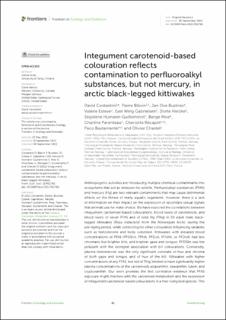| dc.contributor.author | Costantini, David | |
| dc.contributor.author | Blévin, Pierre | |
| dc.contributor.author | Bustnes, Jan Ove | |
| dc.contributor.author | Esteve, Valérie | |
| dc.contributor.author | Gabrielsen, Geir Wing | |
| dc.contributor.author | Herzke, Dorte | |
| dc.contributor.author | Humann-Guilleminot, Ségolène | |
| dc.contributor.author | Moe, Børge | |
| dc.contributor.author | Parenteau, Charline | |
| dc.contributor.author | Récapet, Charlotte | |
| dc.contributor.author | Bustamante, Paco | |
| dc.contributor.author | Chastel, Olivier | |
| dc.date.accessioned | 2022-10-24T13:39:50Z | |
| dc.date.available | 2022-10-24T13:39:50Z | |
| dc.date.created | 2022-10-10T10:13:53Z | |
| dc.date.issued | 2022 | |
| dc.identifier.citation | Frontiers in Ecology and Evolution. 2022, 10, 952765. | en_US |
| dc.identifier.issn | 2296-701X | |
| dc.identifier.uri | https://hdl.handle.net/11250/3028002 | |
| dc.description.abstract | Anthropogenic activities are introducing multiple chemical contaminants into ecosystems that act as stressors for wildlife. Perfluoroalkyl substances (PFAS) and mercury (Hg) are two relevant contaminants that may cause detrimental effects on the fitness of many aquatic organisms. However, there is a lack of information on their impact on the expression of secondary sexual signals that animals use for mate choice. We have explored the correlations between integument carotenoid-based colourations, blood levels of carotenoids, and blood levels of seven PFAS and of total Hg (THg) in 50 adult male black-legged kittiwakes (Rissa tridactyla) from the Norwegian Arctic during the pre-laying period, while controlling for other colouration influencing variables such as testosterone and body condition. Kittiwakes with elevated blood concentrations of PFAS (PFOSlin, PFNA, PFDcA, PFUnA, or PFDoA) had less chromatic but brighter bills, and brighter gape and tongue; PFOSlin was the pollutant with the strongest association with bill colourations. Conversely, plasma testosterone was the only significant correlate of hue and chroma of both gape and tongue, and of hue of the bill. Kittiwakes with higher concentrations of any PFAS, but not of THg, tended to have significantly higher plasma concentrations of the carotenoids astaxanthin, zeaxanthin, lutein, and cryptoxanthin. Our work provides the first correlative evidence that PFAS exposure might interfere with the carotenoid metabolism and the expression of integument carotenoid-based colourations in a free-living bird species. This outcome may be a direct effect of PFAS exposure or be indirectly caused by components of diet that also correlate with elevated PFAS concentrations (e.g., proteins). It also suggests that there might be no additive effect of THg co-exposure with PFAS on the expression of colourations. These results call for further work on the possible interference of PFAS with the expression of colourations used in mate choice. | en_US |
| dc.language.iso | eng | en_US |
| dc.rights | Navngivelse 4.0 Internasjonal | * |
| dc.rights.uri | http://creativecommons.org/licenses/by/4.0/deed.no | * |
| dc.title | Integument carotenoid-based colouration reflects contamination to perfluoroalkyl substances, but not mercury, in arctic black-legged kittiwakes | en_US |
| dc.title.alternative | Integument carotenoid-based colouration reflects contamination to perfluoroalkyl substances, but not mercury, in arctic black-legged kittiwakes | en_US |
| dc.type | Peer reviewed | en_US |
| dc.type | Journal article | en_US |
| dc.description.version | publishedVersion | en_US |
| dc.rights.holder | © 2022 Costantini, Blévin, Bustnes, Esteve, Gabrielsen, Herzke, Humann-Guilleminot, Moe, Parenteau, Récapet, Bustamante and Chastel. | en_US |
| dc.source.pagenumber | 13 | en_US |
| dc.source.volume | 10 | en_US |
| dc.source.journal | Frontiers in Ecology and Evolution | en_US |
| dc.identifier.doi | 10.3389/fevo.2022.952765 | |
| dc.identifier.cristin | 2059944 | |
| dc.relation.project | Norges forskningsråd: 287114 | en_US |
| dc.source.articlenumber | 952765 | en_US |
| cristin.ispublished | true | |
| cristin.fulltext | original | |
| cristin.qualitycode | 1 | |

